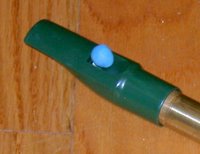I've been doing some research on the origin and use of the words "pennywhistle" and "tin whistle." It seems that usage was uncommon until the 20th century. Robert Clarke began selling his instruments around 1843, but his company was advertising them as "Clarke London Flageolets" or "Clarke Flageolets" in 1900. I checked some early 20th century reference books, and neither the dictionary nor the thesaurus nor the 1911 Encyclopedia Britannica mention either term, although the latter's whistle entry does mention metal flageolets.
Although usage seems to be uncommon, however, both terms do predate Robert Clarke. With the aid of my friendly local librarians I found citations in the Oxford English Dictionary. Note that, unlike most dictionaries, OED inclusion and citations are chronological rather than by popularity so an OED citation does not mean that a word was in common use.
At any rate, the OED's citation for "tin whistle" comes from John Neal's 1825 novel Brother Jonathan:
As if he were sounding a charge with... a tin-whistle.
The OED has multiple citations for "penny whistle:"
1730 Gabriel Odingsells Bay's Opera III. 64 "Musicians with Halters about their Necks—Their Instruments strung behind, penny Whistles, Trumpets, and so forth, in their Hands"
1817 Scott Rob Roy I. x. 233 "Pipes!—They look more like penny-whistles."
1931 N. Douglas London Street Games (ed. 2) 29 "I went down the lane to buy a penny whistle, A copper came by and pinch my penny whistle."
It would seem that the speculation that the words "tin whistle" and "pennywhistle" date back to the first mass production, namely, Clarke's instruments, is probably incorrect:
- The words were in use earlier.
- Clarke and Clarke's company called their products "flageolets" for at least part of their history.
- The words didn't become popular enough to be reflected in dictionaries or encyclopedias until the last half of the 20th century.


